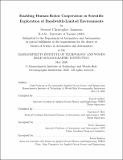Enabling human-robot cooperation in scientific exploration of bandwidth-limited environments
Author(s)
Jamieson, Stewart Christopher.
Download1191819112-MIT.pdf (15.53Mb)
Other Contributors
Massachusetts Institute of Technology. Department of Aeronautics and Astronautics.
Advisor
Yogesh Girdhar and Jonathan P. How.
Terms of use
Metadata
Show full item recordAbstract
Contemporary scientific exploration most often takes place in highly remote and dangerous environments, such as in the deep sea and on other planets. These environments are very hostile to humans, which makes robotic exploration the first and often the only option. However, they also impose restrictive limits on how much communication is possible, creating challenges in implementing remote command and control. We propose an approach to enable more efficient autonomous robot-based scientific exploration of remote environments despite these limits on human-robot communication. We find this requires the robot to have a spatial observation model that can predict where to find various phenomena, a reward model which can measure how relevant these phenomena are to the scientific mission objectives, and an adaptive path planner which can use this information to plan high scientific value paths. We identified and addressed two main gaps: the lack of a general-purpose means for spatial observation modelling, and the challenge in learning a reward model based on images online given the limited bandwidth constraints. Our first key contribution is enabling general-purpose spatial observation modelling through spatio-temporal topic models, which are well suited for unsupervised scientific exploration of novel environments. Our next key contribution is an active learning criterion which enables learning an image-based reward model during an exploration mission by communicating with the science team efficiently. We show that using these together can result in a robotic explorer collecting up to 230% more scientifically relevant observations in a single mission than when using lawnmower trajectories.
Description
Thesis: S.M., Massachusetts Institute of Technology, Department of Aeronautics and Astronautics, May, 2020 Cataloged from the official PDF of thesis. Includes bibliographical references (pages 93-104).
Date issued
2020Department
Massachusetts Institute of Technology. Department of Aeronautics and AstronauticsPublisher
Massachusetts Institute of Technology
Keywords
Aeronautics and Astronautics.